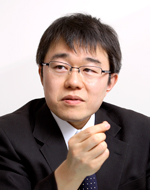2010/09/03
Creating ‚Äúeyes‚ÄĚ and ‚Äúhands‚ÄĚ for surgeons with leading-edge technology and imagination
Associate Professor Ken Masamune
(Department of Mechano-Informatics)

Associate Professor Masamune drives research to apply MRI images not only in diagnosis but also in medical treatment.¬† The goal is to create new ‚Äúeyes‚ÄĚ and ‚Äúhands‚ÄĚ for surgeons by establishing ‚ÄúComputer Aided Surgery‚ÄĚ to support treatment with an engineering approach that integrates information and mechanical technology with clinical medicine.
His first focus was on navigation surgery.  It is a technology to simulate the position of the affected area and surgical instruments such as a surgical knife, the direction of an incision, and its path.  An innovative treatment procedure with minimal damage to normal tissues was developed using this method based on X-ray CT and MRI image information. However, it is much easier to operate if navigation images and affected areas can be displayed together at the same position.
He thus pioneered a display method by overlaying X-ray CT images on a patient’s body using the optical nature of a half-silvered mirror.  It improves accuracy of surgery by precisely overlaying and displaying the position, size, and depth of a tumor.
However, there are issues such as X-ray radiation exposure with X-ray CT and distortion of images with MRI if the magnetic field is inhomogeneous, since MRI requires a high magnetic field. If these issues are addressed, high accuracy diagnosis and treatment will be enabled by real time tomographic images.  Associate Professor Masamune used open MRI which meets the magnetic field requirements and developed a display to overlay tomographic images taken with it on the affected area using a half-silvered mirror.  This image information was combined with surgical instruments used in a strong magnetic field.  This system is the first step towards an advanced and precision system to treat deformation in the affected area and excision processes during surgery as if surgeons could see through inside of the body, and will make it possible to treat the liver, brain, and spinal cord.  The system to be surgeons’ new eyes and hands is surely taking shape.

